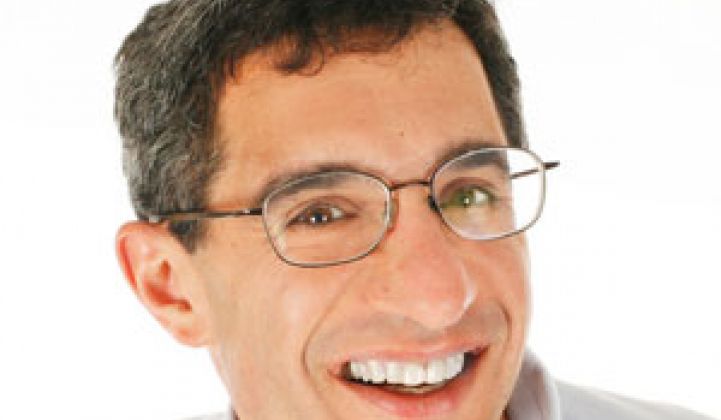The parallel flow-type A/C condensers from Silla or the ones from American Condensers? That is the question for Tesla Motors.
And is Four Seasons still giving us a deal on receiver dryers?
The San Carlos, Calif.-based electric-car maker is at an interesting and pivotal point in its history, and soon it may have to decide whether to continue as an independent company (with or without strategic partners) or get acquired.
First, let’s salute Tesla’s accomplishments.
The company almost single-handedly brought the concept of an electric car back from the deep freeze. Not only that, but it also changed the market for electric cars. Rather than market electric cars as economy cars that can help save the planet, the company made the Tesla Roadster an upscale status symbol. It’s not like eBay's Jeff Skoll put down a reservation on a $98,000 Roadster because his Mercury Sable consumes too much gas on his daily commute.
And, despite a few delays and manufacturing snafus, the company also managed to get their cars out the door, which is better than many other car startups over the last few decades. The company’s waiting list represents more than $60 million in revenue.
But here’s the challenge: How does Tesla move out of the sports-car niche into the wider market for sedans and economy cars? In a lot of ways, sports cars are easier. Customers don’t care so much about cost. They will spend hundreds of thousands of dollars as long as the car 1) outperforms their previous car and 2) will make 25-year-old women think their receding hairline is distinguished rather than pathetic.
Not so with sedans. In the more practical rest of the car world, price matters. And for manufacturers, that means fine-tuning logistics, studying factory operations and landing long-term volume discounts with component suppliers. Tesla’s first sedan, the $60,000 Model S, is due in late 2010. It’s aimed at luxury drivers, but price will still creep in as an issue. When the company tries to release a $30,000 economy car in four years, tradeoffs between price and performance will be front and center. Buyers will ask themselves questions like, “Do I really want to spend $30,000 on a car that can’t make it to L.A. without stopping for a few hours to charge?
This kind of work is not a million laughs. It involves installing project managers and sales reps in glamour spots like Chengdu or Taiyuan to negotiate over the price of synthetic floor mats or cup holders at 2 a.m. in a “gentlemen’s club” on a Tuesday night. It also means going to Detroit and Ohio to meticulously study the intricacies of batteries and drive trains.
Chip companies that make semiconductors for the auto industry say it’s a good business. When you land a contract, a carmaker might buy the same part for nearly a decade. The problem is that landing the contract also might take a decade.
Somehow, this type of grubby, anonymous task mastering just doesn’t strike me as the kind of thing Tesla really wants to do. You can just imagine the reaction of a typical Silicon Valley exec when he’s told that he needs to move to Salt City, Miss., to be closer to braking-system vendors.
Making sedans and economy cars also means recruiting an army of engineers and building highly complex automated factories. (Even if you outsource, you will be involved.) It’s like saying you want to create a startup that’s going to redo the Marshall Plan.
Even if they get a deal with a larger manufacturer in a joint venture, these problems won’t disappear.
But wait. Didn’t Silicon Valley master mass manufacturing? Yes, but there are three important distinctions.
One, chip makers can boost performance by over 60 percent a year, which generates a rapid upgrade cycle and provides the justification for a factory. Batteries, the heart of electric cars, improve about 6 percent a year. In that situation, financing manufacturing is scary.
Two, chip makers were replacing vacuum tubes and have had decades to build up their manufacturing footprint.
And three, most importantly, most of those companies – except for heavyweights like Intel and Samsung – don’t manufacture anymore. They go to foundries like TSMC.
A $60,000 luxury car assembled by the Shenzhen Motor group could be a tough sell. (Established car makers like Ford could step in to act as a foundry, but when they are having troubles of their own, how excited will they be about that?)
So why not sell? “Well, my motivation behind Tesla is really to do as much good as possible for the environment and the electric-vehicle revolution. I think there is still a lot of work to do and if we were to sell to a big company, I'm not sure it would progress at the same pace,” Elon Musk, one of the company founders, told me in an interview earlier this year.
Good point, sort of. General Motors, with its tight corporate embrace, sapped a lot of the energy out of Saturn. Toyota, GM, Ford and Honda didn’t have much luck selling electric cars in the early ’90s and subsequently killed them. A $60,000 sedan won’t put much of a dent in carbon emissions, but it’s a start.
But times have also changed. GM has lost billions, and by all accounts is deadly committed to the Volt, which is primarily electric. Nissan told me last year (before all the hoopla this year) that they are placing big bets on hybrids and electrics. These sorts of companies would likely avoid letting electric-car expertise slip through their fingers now.
And, potentially worse for Tesla, if it remains independent, they might even figure out how to do this well.
The views in this opinion piece are not connected with Greentech Media News.



